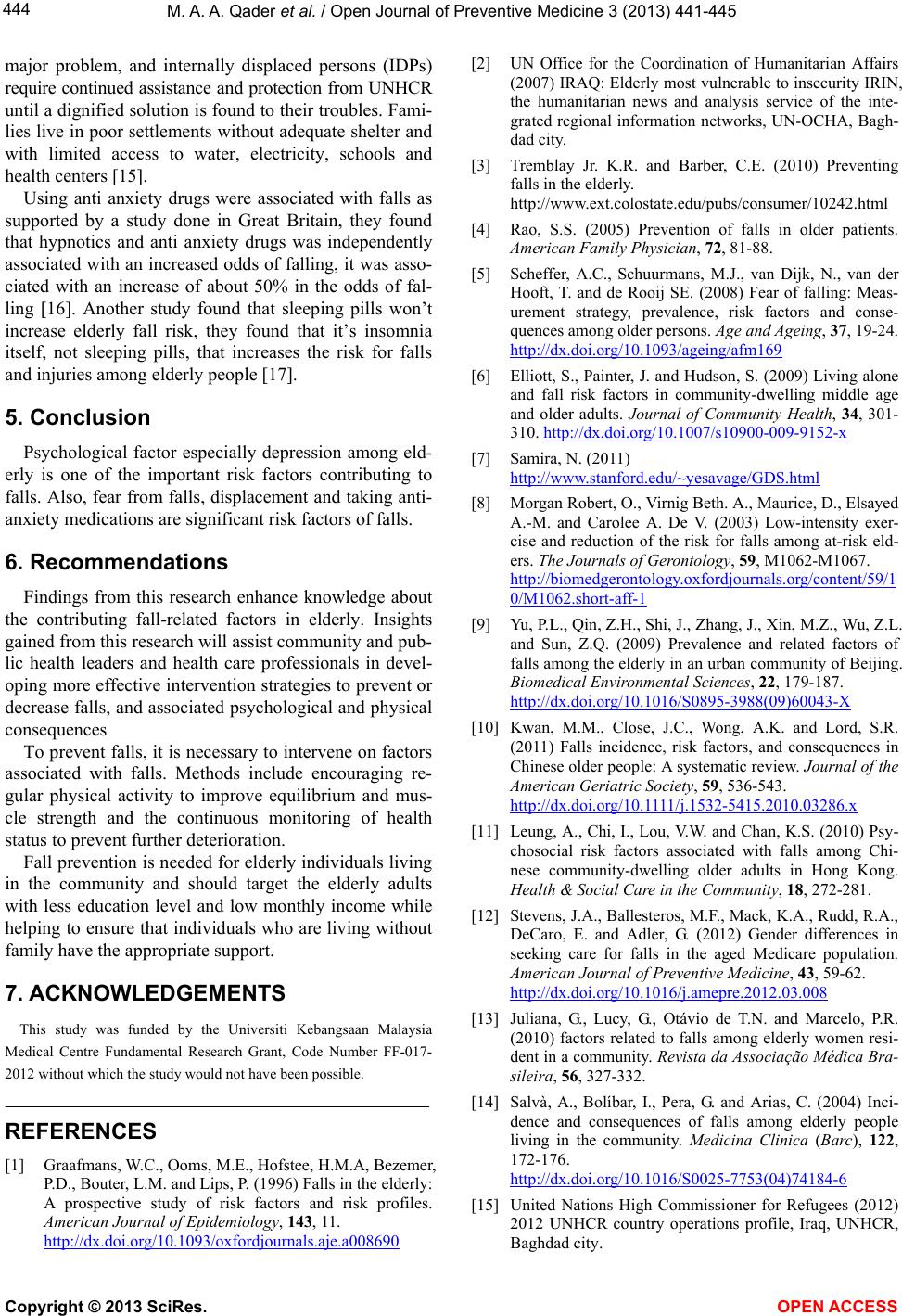
M. A. A. Qader et al. / Open Journal of Preventive Medicine 3 (2013) 441-445
444
major problem, and internally displaced persons (IDPs)
require continued assistance and protection from UNHCR
until a dignified solu tion is found to their troub les. Fami-
lies live in poor settlements without adequate shelter and
with limited access to water, electricity, schools and
health centers [15].
Using anti anxiety drugs were associated with falls as
supported by a study done in Great Britain, they found
that hypnotics and anti anxiety drugs was independently
associated with an increased odds of falling, it was asso-
ciated with an increase of about 50% in the odds of fal-
ling [16]. Another study found that sleeping pills won’t
increase elderly fall risk, they found that it’s insomnia
itself, not sleeping pills, that increases the risk for falls
and injuries among elderly people [17].
5. Conclusion
Psychological factor especially depression among eld-
erly is one of the important risk factors contributing to
falls. Also, fear from falls, displacement and taking anti-
anxiety medications are significant risk factors of falls.
6. Recommendations
Findings from this research enhance knowledge about
the contributing fall-related factors in elderly. Insights
gained from this research will assist community an d pub-
lic health leaders and health care professionals in devel-
oping more effective intervention strategies to prevent or
decrease falls, and associated psychological and physical
consequences
To prevent falls, it is necessary to intervene on factors
associated with falls. Methods include encouraging re-
gular physical activity to improve equilibrium and mus-
cle strength and the continuous monitoring of health
status to prevent further deterioration.
Fall prevention is need ed for elderly individuals living
in the community and should target the elderly adults
with less education level and low monthly income while
helping to en sure that individuals who are living without
family have the appropriate support.
7. ACKNOWLEDGEMENTS
This study was funded by the Universiti Kebangsaan Malaysia
Medical Centre Fundamental Research Grant, Code Number FF-017-
2012 without which the study would not have been poss i b le.
REFERENCES
[1] Graafmans, W.C., Ooms, M.E., Hofstee, H.M.A, Bezemer,
P.D., Bouter, L.M. and Lips, P. (1996) Falls in the elderly:
A prospective study of risk factors and risk profiles.
American Journal of Epidemiology, 143, 11.
http://dx.doi.org/10.1093/oxfordjournals.aje.a008690
[2] UN Office for the Coordination of Humanitarian Affairs
(2007) IRAQ: Elderly most vulnerable to insecurity IRIN,
the humanitarian news and analysis service of the inte-
grated regional information networks, UN-OCHA, Bagh-
dad city.
[3] Tremblay Jr. K.R. and Barber, C.E. (2010) Preventing
falls in the elderly.
http://www.ext.colostate.edu/pubs/consumer/10242.html
[4] Rao, S.S. (2005) Prevention of falls in older patients.
American Family Physici an, 72, 81-88.
[5] Scheffer, A.C., Schuurmans, M.J., van Dijk, N., van der
Hooft, T. and de Rooij SE. (2008) Fear of falling: Meas-
urement strategy, prevalence, risk factors and conse-
quences among ol d er persons. Age and Ageing, 37, 19-24.
http://dx.doi.org/10.1093/ageing/afm169
[6] Elliott, S., Painter, J. and Hudson, S. (2009) Living alone
and fall risk factors in community-dwelling middle age
and older adults. Journal of Community Health, 34, 301-
310. http://dx.doi.org/10.1007/s10900-009-9152-x
[7] Samira, N. (2011)
http://www.stanford.edu/~yesavage/GDS.html
[8] Morgan Robert, O., Virnig Beth. A., Maurice, D., Elsayed
A.-M. and Carolee A. De V. (2003) Low-intensity exer-
cise and reduction of the risk for falls among at-risk eld-
ers. The Journals of Gerontology, 59, M1062-M1067.
http://biomedgerontology.oxfordjournals.org/content/59/1
0/M1062.short-aff-1
[9] Yu, P.L., Qin, Z.H., Shi, J., Zhang, J., Xin, M.Z., Wu, Z.L.
and Sun, Z.Q. (2009) Prevalence and related factors of
falls among the elderly in an urban community of Beijing.
Biomedical Environmental Sciences, 22, 179-187.
http://dx.doi.org/10.1016/S0895-3988(09)60043-X
[10] Kwan, M.M., Close, J.C., Wong, A.K. and Lord, S.R.
(2011) Falls incidence, risk factors, and consequences in
Chinese older people: A systematic review. Journal of the
American Geriatric Society, 59, 536-543.
http://dx.doi.org/10.1111/j.1532-5415.2010.03286.x
[11] Leung, A., Chi, I., Lou, V. W. and Chan, K.S. (2010) Psy-
chosocial risk factors associated with falls among Chi-
nese community-dwelling older adults in Hong Kong.
Health & Social Care in the Community, 18, 272-281.
[12] Stevens, J.A., Ballesteros, M. F., Mack, K.A., Rudd, R.A.,
DeCaro, E. and Adler, G. (2012) Gender differences in
seeking care for falls in the aged Medicare population.
American Journal of Preventive Medicine, 43, 59-62.
http://dx.doi.org/10.1016/j.amepre.2012.03.008
[13] Juliana, G., Lucy, G., Otávio de T.N. and Marcelo, P.R.
(2010) factors related to falls among elderly women resi-
dent in a community. Revista da Associação Médica Bra-
sileira, 56, 327-332.
[14] Salvà, A., Bolíbar, I., Pera, G. and Arias, C. (2004) Inci-
dence and consequences of falls among elderly people
living in the community. Medicina Clinica (Barc), 122,
172-176.
http://dx.doi.org/10.1016/S0025-7753(04)74184-6
[15] United Nations High Commissioner for Refugees (2012)
2012 UNHCR country operations profile, Iraq, UNHCR,
Baghdad city.
Copyright © 2013 SciRes. OPEN A CCESS